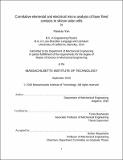Correlative elemental and electrical micro-analysis of laser fired contacts in silicon solar cells
Author(s)
Yen, Patricia, S.M. Massachusetts Institute of Technology
DownloadFull printable version (2.008Mb)
Other Contributors
Massachusetts Institute of Technology. Department of Mechanical Engineering.
Advisor
Tonio Buonassisi.
Terms of use
Metadata
Show full item recordAbstract
Photovoltaic (PV) energy is an abundant and clean alternative to conventional energy sources, which pose an irreversible threat to the environment. For PV to reach cost parity with conventional energy, advances like laser-fired contacts must be adopted to improve cost levers like solar cell efficiency and industrial throughput. This work examines the relationship between laser-processing on the structure and property of solar cells, with the goal of (1) characterizing the differences between using two lasers simultaneously (double-shot lasing) versus a single laser for LFC processing, and (2) using the new findings to optimize industrial LFC efforts. Electrical properties such as lifetime degradation and contact resistance are evaluated using photoluminescence imaging and transmission line measurements, respectively. LFC structures are studied using scanning electron microscope and elemental mapping tools like micro-X-ray fluorescence microscopy and energy dispersive spectroscopy. For the conditions studied, it is unclear whether double-shot lasing can produce higher-quality LFCs than single-shot lasing, although results suggest that the infrared laser influences electrical properties more than the green laser. For future LFC optimization, the [mu]-XRF maps of elemental distribution may offer a novel way to evaluate LFC formation.
Description
Thesis: S.M., Massachusetts Institute of Technology, Department of Mechanical Engineering, 2016. This electronic version was submitted by the student author. The certified thesis is available in the Institute Archives and Special Collections. Cataloged from student-submitted PDF version of thesis. Includes bibliographical references (pages 53-62).
Date issued
2016Department
Massachusetts Institute of Technology. Department of Mechanical EngineeringPublisher
Massachusetts Institute of Technology
Keywords
Mechanical Engineering.